Renault Espace
| Renault Espace | |
|---|---|
_%E2%80%93_Frontansicht%2C_18._Oktober_2015%2C_D%C3%BCsseldorf.jpg) | |
| Overview | |
| Manufacturer | Renault |
| Production | 1984–present |
| Body and chassis | |
| Class |
Large MPV (M) (1984–2014) Mid-size crossover (2015–present)[1] |
| Body style |
5-door MPV (1984–2014) 5-door SUV (2015–present)[1] |
The Renault Espace is a mid-size luxury crossover[1][2] manufactured by Renault currently in its fifth generation.
The first three generations Espace was among the first contempoary minivans or MPVs and were manufactured by Matra for Renault. The Renault Grand Espace is a long-wheelbase (LWB) version with increased rear leg room and boot size. The name "Espace" means "space" in French.
In February 2012, the Espace was retired in the United Kingdom, as part of a cost cutting plan.[3]
Espace I (1984–1991)
| Espace I | |
|---|---|
 1984 Espace 2000 TSE | |
| Overview | |
| Production | 1984–1991 |
| Assembly | Romorantin, France (Matra) |
| Layout | Front-engine, front-wheel-drive (FWD) / Front-engine |
| Powertrain | |
| Engine |
petrol 2.0 8 valve I4 2.2 8 valve I4 diesel 2.1 TD 8 valve I4 |
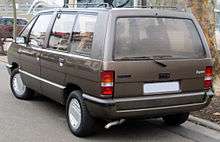
The Espace's design was originally conceived in the 1970s by the British designer Fergus Pollock, who was working for Chrysler UK, at its design centre at Whitley in Coventry.[4] Later, Matra, which was affiliated with Simca, the then French subsidiary of Chrysler, was involved in partnership in the design, spearheaded by Greek designer Antonis Volanis.
The Espace was originally intended to be sold as a Talbot, and to be a replacement for the Matra Rancho leisure activity vehicle. Early prototypes used Simca parts, and hence featured a grille reminiscent of the Simca 1307 (Chrysler Alpine).
In 1978, six years before the Espace went into production, Chrysler UK and Simca were sold to the French company PSA Peugeot Citroën, which phased out Simca within a decade because of falling sales. PSA decided the Espace was too expensive and too risky a design to put into production, so it was given to Matra, which took the idea to Renault.
The Matra concept became the Renault Espace. The design featured a fibreglass body mounted on a warm-galvanised steel chassis, using the same technique and assembly line at the factory as the Talbot Matra Murena. The introduction of the Espace required the relatively small factory to cease the production of the Murena to make room for the Espace.
The Espace was eventually launched by Renault in July 1984. After a slow start, a mere nine Espaces were sold in the first month,[5] consumers realised the benefits of the MPV concept and the Espace became popular. It was sold in the United Kingdom from August 1985. In October 1984 the turbodiesel versions Turbo D and Turbo DX arrived. To accommodate the diesel engine, these have a protruding grille and a correspondingly larger front bumper.

In 1984, American Motors Corporation (AMC) announced it would begin to market the front wheel drive Espace in the United States.[6][7] The minivan was exhibited to consumers at the 1985 Chicago Auto Show, but AMC's negotiations with Matra continued over the vehicle's import pricing.[8] Plans for the Espace to be launched in the U.S. ended with the purchase of AMC by Chrysler.
In 2004, BBC's motoring show Top Gear set up a race between two Espaces, a Toyota Previa, a Toyota MasterAce, a Mitsubishi Space Wagon, and a Nissan Serena. The Espaces came first and second.
Facelift

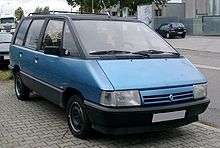
Building upon its success, the Espace was revamped in 1988, with most of the Talbot/Simca content being replaced by equivalent Renault parts. The chassis and mechanical components of the car remained largely unchanged.
The most obvious cosmetic exterior difference, between the very first Espaces and the revamped post 1988 models, were the changed headlights: the forward slanting lights with orange indicator casing of the original Espace were replaced with backward slanting lights, with a clear indicator casing.
Along with the changes in design, a four wheel drive version called Quadra was also introduced.[9]
Espace II (1991–1997)
| Espace II | |
|---|---|
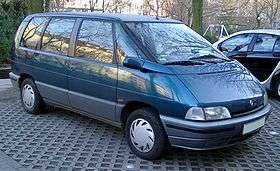 | |
| Overview | |
| Also called | Renault Univers (China) |
| Production |
1991–1997 (F) 1994–1999 (PRC) |
| Assembly |
Romorantin, France (Matra) Xiaogan, China (SRAC) |
| Layout | Front-engine, front-wheel-drive / four-wheel-drive |
| Powertrain | |
| Engine |
petrol 2.0 8v I4 2.2 8v I4 2.9 24v V6 3.5 40v V10 diesel 2.1 TD 8v I4 |
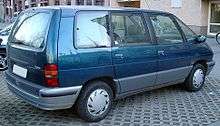
A heavily revised Espace was launched in January 1991, adopting the Renault family look, to replace the Talbot themed styling of the original. This was essentially a re skin of the original car, with a new dashboard and other interior improvements. The chassis was unchanged. Production ceased in October 1996.
In an episode of Top Gear, then presenter Jeremy Clarkson referred to this generation as "probably the best of the MPVs". However, he went on to say "but that's like saying, "Oh good, I've got syphilis, the best of the sexually transmitted diseases!".
Espace F1


In 1995, Renault displayed a show car called the Espace F1, which was created by Matra to celebrate both the tenth anniversary of the Espace and Renault's involvement in Formula One racing. Though it resembled an Espace with substantial bodywork changes, the vehicle had more in common with a Formula One car.
The vehicle used a lightweight carbon fibre F1 style chassis in combination with a carbon fibre-reinforced Espace J63 series body (as opposed to fibreglass on the standard model). Powering the Espace F1 was an 800 PS (588 kW) (upgraded from its original rating of 700 PS (515 kW)) 3.5 litre, forty valve Renault RS5 V10 engine, as used in the 1993 Williams-Renault FW15C.
As with an F1 car, the V10 engine was mid-engined (as opposed to the conventional front-engined layout) and the power was transmitted to the rear wheels via a six speed semi automatic gearbox, also used in the Williams FW15C. The engine and transmission allowed the Espace F1 to accelerate from 0–100 km/h (0–62 mph) in 2.8 seconds, 0–200 km/h (0–124 mph) in 6.9 seconds and carry on accelerating to a top speed of 312 km/h (194 mph). With the use of carbon ceramic brakes, the Espace F1's deceleration was no less impressive that its acceleration, and could accelerate from 0–270 km/h (0–168 mph) and brake to a complete halt in under 600 metres (1,969 ft).
This version of the Espace was featured in driving simulator game Gran Turismo 2. Frank Williams was a noted passenger of the Espace F1, chauffeured by Williams driver David Coulthard.[10] The Espace F1 currently resides in the Matra Museum in France.[11]
Espace III (1996–2002)
| Espace III | |
|---|---|
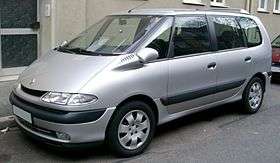 | |
| Overview | |
| Production | 1996–2002 |
| Assembly |
Romorantin, France (Matra) Xiaogan, China (SRAC) |
| Body and chassis | |
| Related | Renault Avantime |
| Powertrain | |
| Engine |
2.0 8v I4 2.0 16v I4 3.0 PRV 3.0 24v PSA 1.9 dTi 12v I4 2.2 dTi 12v I4 2.2 dCi 16v I4 |
| Dimensions | |
| Length |
4,517 mm (177.8 in) 4,787 mm (188.5 in) (Grand Espace) |
| Width |
1,810 mm (71.3 in) 2,070 mm (81.5 in) (Grand Espace) |
| Height |
1,690 mm (66.5 in) 1,700 mm (66.9 in) (Grand Espace) |
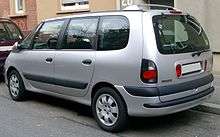
The third generation Espace arrived in December 1996, with the long wheelbase Grand Espace coming to market in the beginning of 1998. The most notable feature of the Espace III was the radically futuristic interior (including an elongated and centrally mounted dashboard, digital speedometer and radio/CD display). The Espace III featured a plastic (GRP) body over a galvanised independent steel chassis.
The Espace III shared much of its running gear with the Laguna of the same era. Although Renault badged, the Espace III continued to be built by Matra. A number of third generation Espaces were used as bases for NGV and taxi conversions for the Kuala Lumpur International Airport and the Kuala Lumpur Sentral transportation hub in Malaysia, rebranded as Enviro 2000s.
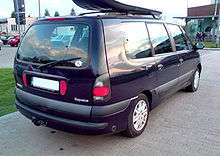
The third generation Espace was the last Espace to be built by Matra (The short lived Avantime was subsequently produced on the same production line). During 2001, Matra and MG Rover discussed a possible deal to build reskinned Espaces, as well as market them. However, the deal failed to happen.[12][13]
Production ended in September 2002, with the final production number being 357,120.

Espace IV (2002–2014)
| Espace IV | |
|---|---|
_%E2%80%93_Frontansicht%2C_17._Juli_2011%2C_Ratingen.jpg) | |
| Overview | |
| Production | 2002–2014[14][15][16][17] |
| Assembly | Sandouville, France (Sandouville Factory)[14][16][17] |
| Layout | Front-engine, front-wheel drive |
| Powertrain | |
| Engine |
petrol 2.0 I4 2.0T I4 3.5 V6 diesel 1.9 I4 2.0 I4 2.2 I4 3.0 V6 |
| Transmission |
6-speed manual 5-speed automatic 6-speed automatic |
| Dimensions | |
| Wheelbase |
2,803 mm (110.4 in) (Espace)[18] 2,868 mm (112.9 in) (Grand Espace)[19] |
| Length |
4,661 mm (183.5 in) (Espace)[18] 4,859 mm (191.3 in) (Grand Espace)[19] |
| Width | 1,859 mm (73.2 in)[18][19] |
| Height |
1,730 mm (68.1 in) (Espace)[18] 1,750 mm (68.9 in) (Grand Espace)[19] |
_%E2%80%93_Heckansicht_(1)%2C_17._Juli_2011%2C_Ratingen.jpg)
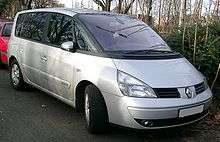
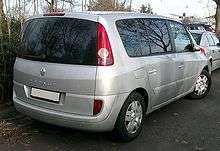
The fourth generation Espace arrived in November 2002, being the first entirely Renault developed and produced model. This model is 90% recyclable, and contains numerous weight reducing materials, thus cutting fuel consumption. The aluminium doors and bonnet are some 20 kg lighter than steel equivalents.
Its styling was reflective of a new design direction at Renault, symbolised by the radical Vel Satis and Avantime models, marking a major departure from the previous model, which also saw the range moved upmarket.
In 2006, the Espace received a thorough facelift (Phase II) and added new 2.0 litre and 3.0 litre dCi engines.[20] In October 2010, a slight redesign was unveiled at the Paris Motor Show (Phase III), with minor cosmetic changes, LED lights and improved equipment.[21]
On 22 June 2012, Renault announced a restyling of the Espace (Phase IV), the second important after 2006,[22][23][24] incorporating the "family feeling" design concept of Laurens van den Acker. Also, it introduced new 2.0 dCi (M9R) engines, in order to meet the French regulations regarding the limitations on CO2 emissions.[22] The car continued in production until the launch of a new generation.[23]
In 2002, Renault goals were to deliver 450,000 units of the Espace IV before 2009, which would account for 20% of the European market for an MPV. The fourth generation Espace came third from the bottom in the Top Gear Satisfaction Survey 2005.
Safety
The Espace IV passed the Euro NCAP car safety tests with following ratings:[25]
| Adult Occupant: | |
| Pedestrian: |
The 2003 Espace featured in British motoring television show Fifth Gear, where it was crashed into a 1990s Land Rover Discovery at 64 km/h (40 mph). The passenger compartment in the Espace was kept fairly intact, but the dummy in the Discovery was smashed between the seats and the dashboard, leaving no survival possibilities.
Reviews
The Renault Espace IV has received very good reviews from motoring journalists and is often cited as one of the best vehicles in the large MPV class.
- The AA









 [26]
[26]
'The [Espace] is the MPV to beat all MPVs; it's spacious, luxurious and drives well for a car this size. And there's no question of it being mistaken for anything else on the road.' - Autocar




 [27]
[27]
'The interior is well executed, but even the Grand Espace isn't that spacious with seven on board. Build quality is impressive, as are the diesels, but avoid petrol power.' - Auto Express




 [28]
[28]
'The restyle hasn't dented the visual appeal of the Espace. Yet although the interior is more practical, it's simply not as versatile as the cabins of rivals such as the new Ford Galaxy, or upmarket competitors like Land Rover's Discovery.' - Car




 [29]
[29]
For: Gigantic
Against: A bit unwieldy - Parker's




 [30]
[30]
Pros: Masses of cabin room, superb long distance cruiser, strong dCi engines
Cons: Can be expensive to buy, seats don't fold flat, sheer size makes it tricky to manoeuvre - Top Gear









 [31]
[31]
'The last word in MPVs, the Renault Espace is simply vast, but manages to be stylish and unconventional at the same time. Available in regulation and Behemoth 'Grand' guises, either is the ultimate solution for those with a distrust of birth control.' - What Car?




 [32]
[32]
'Decent space for people, if not their luggage. The Espace offers a refined drive and some refined engines, but some rivals are cheaper and more versatile.'
Espace V (2015–present)
| Espace V | |
|---|---|
 | |
| Overview | |
| Production | 2015–present |
| Assembly | Douai, France (Douai Renault Factory) |
| Body and chassis | |
| Layout | Front-engine, front-wheel-drive |
| Platform | Renault CMF platform (CMF-CD) |
| Dimensions | |
| Wheelbase | 2,884 mm (113.5 in) |
_%E2%80%93_Heckansicht%2C_2._Mai_2015%2C_D%C3%BCsseldorf.jpg)
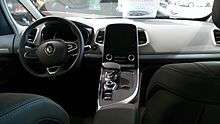
The fifth generation Espace was unveiled at the 2014 Paris Motor Show in October 2014. It abandons the large MPV design of previous generations, instead having a mid size crossover styling. The car is based on the Renault–Nissan Common Module Family architecture developed by both Renault and Nissan.[2]
The Renault Espace has radar Adaptive Cruise Control, and active emergency braking.[33] It is offered with the latest version of Renault's R Link 2 infotainment system (voice control, navigation, Bluetooth and radio), engine stop start, emergency brake assist, lane departure warning and road sign recognition with speed limit alerts, 360 degree sensors, reversing camera and a hands free parking system.
The Espace V is only available in LHD markets, with no RHD vehicles built or sold.[34]
Initiale Paris
| Renault Initiale Paris | |
|---|---|
.jpg) The Renault Initiale Paris concept | |
| Overview | |
| Manufacturer | Renault |
| Production | 2013 (Concept car) |
| Body and chassis | |
| Class | Mid-size luxury crossover |
| Body style | 5-door SUV |
| Layout | Front-engine, front-wheel-drive |
| Dimensions | |
| Wheelbase | 2,884 mm (113.5 in) |
| Chronology | |
| Predecessor |
Renault Egeus Renault Ondelios |
The fifth generation Espace was preceded by the Initiale Paris concept car, which is similar to the production version. The concept was unveiled in September 2013 at the Frankfurt Motor Show and it has a mid-size luxury crossover SUV-like design and various luxury elements,[35] previewing also the new Renault's Initiale Paris luxury sub-marque.[36]
The car incorporates an aluminium–poly(methyl methacrylate) roof which has a map of Paris.[37]
The engine is a 1.6-litre diesel unit.[35] The Initiale Paris is the final installment of Laurens van den Acker's "cycle of life" six-concept series, with each one representing, according to Renault, a lifetime moment: "love" (Renault DeZir), "explore" (Renault Captur), "family" (Renault R-Space), "work" (Renault Frendzy), "play" (Renaults Twin'Z and Twin'Run) and "wisdom" (Renault Initiale Paris).[38]
Engine Specifications
| Model | Year(s) | Displacement | Fuel Type | Power | Torque | 0–100 km/h (0–62 mph) | CO2 Emissions |
|---|---|---|---|---|---|---|---|
| TCe 200 EDC7[39] | 2015–2017 | 1,618 cc (98.7 cu in) | Petrol | 200 PS (147 kW; 197 bhp) | 260 N·m (192 ft·lbf) | 8.5 s | 140 g/km |
| TCe 200 EDC7[40] | 2017– | 1,798 cc (109.7 cu in) | Petrol | 225 PS (165 kW; 222 bhp) | 300 N·m (221 ft·lbf) | 7.6 s | 152 g/km[41] |
| Model | Year(s) | Displacement | Fuel Type | Power | Torque | 0–100 km/h (0–62 mph) | CO2 Emissions |
|---|---|---|---|---|---|---|---|
| dCi 130[42] | 2015– | 1,598 cc (97.5 cu in) | Diesel | 131 PS (96 kW; 129 bhp) | 320 N·m (236 ft·lbf) | 10.8 s | 119 g/km |
| dCi Twin Turbo 160 EDC6[43] | 2015– | 1,598 cc (97.5 cu in) | Diesel | 160 PS (118 kW; 158 bhp) | 380 N·m (280 ft·lbf) | 9.7 s | 123 g/km |
See also
- Renault Captur, the mini SUV of the manufacturer
- Renault Modus, the mini MPV of the manufacturer
- Renault Scénic, the compact MPV of the manufacturer
References
- 1 2 3 Diem, William (2014-10-03). "Renault's Reinvented Espace CUV steals show in Paris". Wards Auto. Retrieved 2014-10-07.
- 1 2 "Reinvented Renault Espace revealed". Autocar. 2014-10-02. Retrieved 2014-10-06.
- ↑ "Renault to cut five UK models". telegraph.co.uk. 19 December 2011.
- ↑ Lewin, Tony (2003). How to Design Cars Like a Pro: A Complete Guide to Car Design from the Top Professionals. Motorbooks International. ISBN 0-7603-1641-4.
- ↑ https://www.youtube.com/watch?v=3VJDIeeSdAE Top Gear - Historic People Carrier Racing - official Top Gear YouTube channel provided legally by BBC
- ↑ Stepler, Richard (February 1985). "New generation minivans". Popular Science. 226 (2): 74–75. Retrieved 7 September 2014.
- ↑ "A.M.C. to Import Renault Mini-Van". The New York Times. 3 October 1984. Retrieved 7 September 2014.
- ↑ Mateja, James (13 March 1985). "AMC Will Not Import New, Larger Alliance". Chicago Tribune. Retrieved 6 September 2014.
- ↑ http://www.motorsportmagazine.com/archive/article/march-1988/28/impressions
- ↑ "Matra Williams Renault Espace F1". Williamsdb.com. 17 December 2012. Retrieved 7 September 2014.
- ↑ "Le Musée" (in French). Musée Matra. Retrieved 7 September 2014.
- ↑ Simeli, Asopèe. "L'affaire Renault". Austin-rover.co.uk. Archived from the original on 7 November 2007. Retrieved 7 September 2014.
- ↑ "New Rover 45 delayed one more time". autocar.co.uk. Retrieved 14 May 2015.
- 1 2 "Renault Atlas (May 2012)" (PDF). Renault. Archived (PDF) from the original on 3 August 2012. Retrieved 3 August 2012.
- ↑ "Renault reveals 2013 Espace Minivan: Sales commence in July (Photos)". Rushlane.com. 24 June 2012. Retrieved 4 August 2012.
- 1 2 "Guide to assembly plants in Europe 2012" (PDF). Autonews.com. Retrieved 4 August 2012.
- 1 2 "Alpine Factory (Dieppe)". Renault Sport Media Website. 12 March 2012. Retrieved 4 August 2012.
- 1 2 3 4 Archived 13 November 2010 at the Wayback Machine.
- 1 2 3 4 Archived 2 February 2014 at the Wayback Machine.
- ↑ "Renault Espace Gets Another Facelift" (Press release). Worldcarfans.com. 8 February 2006. Retrieved 7 September 2014.
- ↑ "Renault Espace: isn’t space the ultimate luxury?". Renault Motor Shows blog. 13 October 2010. Archived from the original on 13 December 2010. Retrieved 7 September 2014.
- 1 2 "New Renault Espace: continuing to define luxury…". Renault. 22 June 2012. Retrieved 5 August 2012.
- 1 2 "New Renault Espace facelift previewed". Worldcarfans.com. Retrieved 5 August 2012.
- ↑ Radu, Mihnea (15 May 2012). "Renault Espace Gets Another Facelift". Autoevolution.com. Retrieved 5 August 2012.
- ↑ "Renault Espace | Euro NCAP - For safer cars crash test safety rating". Euro NCAP. Retrieved 2010-12-02.
- ↑ "Car Reviews: Renault Grand Espace 2.0 dCi Privilege". The AA. Retrieved 2010-12-02.
- ↑ "Renault Grand Espace 3.0 V6 dCi Privilège Auto". Autocar.co.uk. Archived from the original on 22 February 2012. Retrieved 2010-12-02.
- ↑ "Renault Grand Espace | First Drives | Car Reviews". Auto Express. 2006-04-12. Retrieved 2010-12-02.
- ↑ "Renault Grand Espace - 2.0 dCi Dynamique (150bhp) 5d Auto - Car Data". Parkers.co.uk. Archived from the original on 16 July 2011. Retrieved 2010-12-02.
- ↑ "New Renault Grand Espace Car Review - Parker's". Parkers.co.uk. Archived from the original on 24 October 2010. Retrieved 2010-12-02.
- ↑ "Renault Espace/Grand Espace expert car review verdict - BBC Top Gear". Topgear.com. Archived from the original on 8 February 2011. Retrieved 2010-12-02.
- ↑ "Renault Espace MPV - Summary - New Car Review - What Car?". Whatcar.com. Archived from the original on 28 May 2010. Retrieved 2010-12-02.
- ↑ http://group.renault.com/en/passion-2/innovation/renault-a-born-innovator/adas-a-range-of-technologies-promoting-safety-and-easier-driving-experience/
- ↑ http://www.autoexpress.co.uk/renault/espace/88717/new-renault-espace-at-the-2014-paris-motor-show
- 1 2 Kew, Ollie (10 September 2013). "Renault Initiale Paris concept (2013) at Frankfurt motor show". carmagazine.co.uk. Car. Retrieved 20 October 2014.
- ↑ Rendell, Julian (10 September 2013). "Renault Initiale Paris concept shown". Autocar. Retrieved 20 October 2014.
- ↑ Wilkinson, Leo (10 September 2013). "Renault Initiale Paris concept car hints at next Espace". telegraph.co.uk. Telegraph Media Group. Retrieved 20 October 2014.
- ↑ "Renault Initiale Paris Concept". Car Body Design. 12 September 2013. Retrieved 20 October 2014.
- ↑ "2015 Renault Espace 5 Zen TCe 200 EDC7 Technical Specifications". ultimatespecs.com.
- ↑ "Renault Espace dostal motor 1,6l z Alpine A110, šestnáctistovak končí". Autobible.cz.
- ↑ "Introducing Renault ESPACE model 2017 with the new TCe 225 EDC petrol engine". Renault.
- ↑ "2015 Renault Espace 5 Zen dCi 130 Technical Specifications". ultimatespecs.com.
- ↑ "2015 Renault Espace 5 Zen dCi Twin Turbo 160 EDC6 Technical Specifications". ultimatespecs.com.
Further reading
- Chapman, Giles (27 July 2004). "Classic Cars: The Renault Espace". The Independent. London. Retrieved 7 September 2014.
External links
| Wikimedia Commons has media related to Renault Espace. |
| « previous — Renault car timeline, 1940s–1980s — next » | |||||||||||||||||||||||||||||||||||||||||||||
|---|---|---|---|---|---|---|---|---|---|---|---|---|---|---|---|---|---|---|---|---|---|---|---|---|---|---|---|---|---|---|---|---|---|---|---|---|---|---|---|---|---|---|---|---|---|
| Type | 1940s | 1950s | 1960s | 1970s | 1980s | ||||||||||||||||||||||||||||||||||||||||
| 5 | 6 | 7 | 8 | 9 | 0 | 1 | 2 | 3 | 4 | 5 | 6 | 7 | 8 | 9 | 0 | 1 | 2 | 3 | 4 | 5 | 6 | 7 | 8 | 9 | 0 | 1 | 2 | 3 | 4 | 5 | 6 | 7 | 8 | 9 | 0 | 1 | 2 | 3 | 4 | 5 | 6 | 7 | 8 | 9 | |
| Economy car | 3 / 4 | 4 | |||||||||||||||||||||||||||||||||||||||||||
| Supermini | 5 / 7 | 5 | |||||||||||||||||||||||||||||||||||||||||||
| Small family car | Juvaquatre | Dauphine | 6 | 14 | 9 / 11 | 19 | |||||||||||||||||||||||||||||||||||||||
| 4CV | 8 / 10 | ||||||||||||||||||||||||||||||||||||||||||||
| Large family car | Colorale | 12 | 18 | 21 | |||||||||||||||||||||||||||||||||||||||||
| Executive car | Frégate | 16 | 20 / 30 | 25 | |||||||||||||||||||||||||||||||||||||||||
| Coupé | 15 / 17 | Fuego | |||||||||||||||||||||||||||||||||||||||||||
| Torino | |||||||||||||||||||||||||||||||||||||||||||||
| Roadster | Caravelle | ||||||||||||||||||||||||||||||||||||||||||||
| Sports car | Alpine A610 | ||||||||||||||||||||||||||||||||||||||||||||
| Large MPV | Espace | ||||||||||||||||||||||||||||||||||||||||||||
| Off-roader | Rodeo 4 / 6 | Rodeo | |||||||||||||||||||||||||||||||||||||||||||
| Van | Estafette | Trafic | |||||||||||||||||||||||||||||||||||||||||||
| Master | |||||||||||||||||||||||||||||||||||||||||||||
| « previous — Renault vehicles timeline 1980 to date, Western European and North American market | ||||||||||||||||||||||||||||||||||||||||||||
|---|---|---|---|---|---|---|---|---|---|---|---|---|---|---|---|---|---|---|---|---|---|---|---|---|---|---|---|---|---|---|---|---|---|---|---|---|---|---|---|---|---|---|---|---|
| Type | 1980s | 1990s | 2000s | 2010s | ||||||||||||||||||||||||||||||||||||||||
| 0 | 1 | 2 | 3 | 4 | 5 | 6 | 7 | 8 | 9 | 0 | 1 | 2 | 3 | 4 | 5 | 6 | 7 | 8 | 9 | 0 | 1 | 2 | 3 | 4 | 5 | 6 | 7 | 8 | 9 | 0 | 1 | 2 | 3 | 4 | 5 | 6 | ||||||||
| City car | 4 | Twingo I | Twingo II | Twingo III | ||||||||||||||||||||||||||||||||||||||||
| Twizy | ||||||||||||||||||||||||||||||||||||||||||||
| Supermini | 5 / 7 | Super 5 | Clio Symbol | Symbol II | ||||||||||||||||||||||||||||||||||||||||
| Clio I | Clio II | Clio III | Clio IV | |||||||||||||||||||||||||||||||||||||||||
| Zoe | ||||||||||||||||||||||||||||||||||||||||||||
| Small family car | 14 | 9 / 11 | 19 | Fluence | ||||||||||||||||||||||||||||||||||||||||
| Alliance / Encore | Mégane I | Mégane II | Mégane III | Mégane IV | ||||||||||||||||||||||||||||||||||||||||
| Large family car | 18 | 21 / Medallion | Laguna I | Laguna II | Laguna III | Talisman | ||||||||||||||||||||||||||||||||||||||
| Executive car | 20 / 30 | 25 | Safrane | Vel Satis | Latitude | |||||||||||||||||||||||||||||||||||||||
| Coupé | Fuego | Avantime | Laguna Coupé | |||||||||||||||||||||||||||||||||||||||||
| Roadster | Spider | Wind | ||||||||||||||||||||||||||||||||||||||||||
| Crossover SUV | Captur | |||||||||||||||||||||||||||||||||||||||||||
| Kadjar | ||||||||||||||||||||||||||||||||||||||||||||
| Koleos | ||||||||||||||||||||||||||||||||||||||||||||
| Mini MPV | Modus | |||||||||||||||||||||||||||||||||||||||||||
| Compact MPV | Scénic I | Scénic II | Scénic III | |||||||||||||||||||||||||||||||||||||||||
| Large MPV/CUV | Espace I | Espace II | Espace III | Espace IV | Espace V | |||||||||||||||||||||||||||||||||||||||
| LAV | Express | Kangoo I | Kangoo II | |||||||||||||||||||||||||||||||||||||||||
| Van | Trafic I | Trafic II | Trafic III | |||||||||||||||||||||||||||||||||||||||||
| Master I | Master II | Master III | ||||||||||||||||||||||||||||||||||||||||||